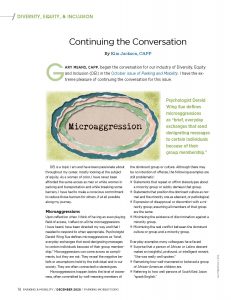By Kim Jackson, CAPP
 GARY MEANS, CAPP, began the conversation for our industry of Diversity, Equity and Inclusion (DEI) in the October issue of Parking and Mobility. I have the extreme pleasure of continuing the conversation for this issue.
GARY MEANS, CAPP, began the conversation for our industry of Diversity, Equity and Inclusion (DEI) in the October issue of Parking and Mobility. I have the extreme pleasure of continuing the conversation for this issue.
DEI is a topic I am and have been passionate about throughout my career, mostly looking at the subject of equity. As a woman of color, I have never been afforded the same access as men or white women in parking and transportation and while breaking some barriers, I have had to make a conscious commitment to reduce those barriers for others, if at all possible along my journey.
Microaggressions
Upon reflection when I think of having an even playing field of access, I reflect on all the microaggressions I have heard, have been directed my way and that I needed to respond to when appropriate.
Psychologist Derald Wing Sue defines microaggressions as “brief, everyday exchanges that send denigrating messages to certain individuals because of their group membership.” Microaggressions can come across as compliments, but they are not. They reveal the negative beliefs or assumptions held by the individual and in our society. They are often connected to stereotypes.
Microaggressions happen below the level of awareness, often committed by well-meaning members of the dominant group or culture. Although there may be no intention of offense, the following examples are still problematic:
- Statements that repeat or affirm stereotypes about a minority group or subtly demean that group.
- Statements that position the dominant culture as normal and the minority one as aberrant, or pathological.
- Expression of disapproval or discomfort with a minority group; assuming all members of that group are the same.
- Minimizing the existence of discrimination against a minority group.
- Minimizing the real conflict between the dominant culture or group and a minority group.
Everyday examples many colleagues have faced:
- Surprise that a person of African or Latino descent makes an insightful, profound, or intelligent remark. “She was really well spoken.”
- Remarking how well-mannered or behaved a group of African-American children are.
- Referring to how well persons of South East Asian “speak English.”
Moving Away from Bias
The question we need to begin asking ourselves is how we move away from bias and reduce microaggressions. Here are some possible approaches:
Become more culturally literate. Learn about people who are different from yourself—gender orientation, class status, culture, and ethnicity
Make the unconscious conscious—increase your awareness:
- Understand that bias is a normal part of the human experience; yet we do not need to wallow in it, nor do we need to carry inordinate shame about it.
- Explore your own personal narrative. What values and behaviors did you learn growing up? How have those shaped how you see the world? What other cultures, classes, sexual orientation, and genders were you exposed to as a child?
- Develop the capacity for self-observation. Compassionately see yourself in action, see yourself as others might. Share with others what your thoughts are (in a non-judgmental safe setting). Move away from knee-jerk reactions and habitual reactions
- Create the PAUSE*, before you react:
- Pay attention to what’s happening beneath the judgments and assessments. Slow down and really see what is happening.
- Acknowledge your own reactions, interpretations, and judgments. Recognizing interpretations as interpretations moves you away from constructing them as fact.
- Understand the other possible reactions, interpretations and judgments that are possible.
- Search for the most constructive, empowering, or productive way to deal with a situation.
- Execute your action plan.
- Explore awkwardness or discomfort
- Am I reacting to what is happening now? Is this person or situation currently threatening to me? Is there any immediate action that needs to be taken? How do people or situations like this affect my behavior on a regular basis? Is there somebody with whom I should talk about the circumstances?
- Get out of your comfort zone and engage with people who are different from you.
- Get feedback and information from others.
We are hopeful this column in the magazine is helping you think about and begin to conduct these conversations within your organization. Please send any feedback on this article to me—my email address is below.
Some of this information comes from Everyday Bias by Howard Ross.
KIM JACKSON, CAPP, is director of parking and transportation at Princeton University and former chair of IPMI’s Board of Directors. She can be reached at kimj@princeton.edu.
DOWNLOAD THE FULL ARTICLE HERE.
READ THIS PARKING & MOIBILITY ISSUE ONLNE.
